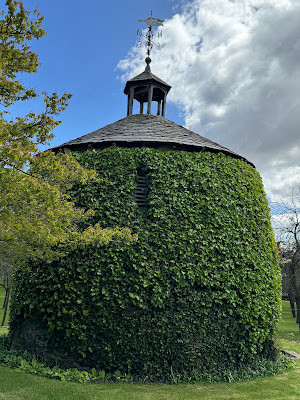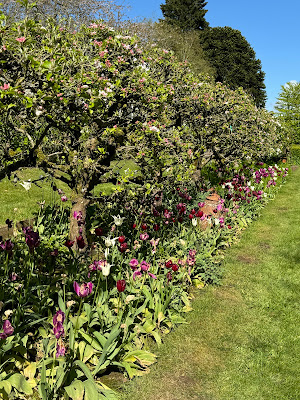The process took only minutes, and my husband liked how easy it was to assemble and hang on the tree in our garden. Our grandson loved pouring the bird feed in, and I was surprised at how much the feeder held.
Thinking of the days
SNV30239

Blogging about
I blog about:
Thursday, 22 August 2024
Days of feeding the birds : a review of the Finches Friend Cleaner feeder 2
Friday, 19 April 2024
A day at Stockton Bury Gardens, Herefordshire
I was in rural Herefordshire a few days ago for a press event for twenty members of the garden press and influencers at Stockton Bury Gardens which is open to the public. I've longed to see these gardens for quite a while, so how did they measure up to the rather high expectations I had?
Springtime at Stockton Bury charms you immediately as you enter and face eight acres of cider orchards lying between garden and farmland.
Tamsin Westhorpe is both curator and a gardener here, and a fascinating and funny host for the day as she enthuses us all with how five generations of her family have lived here, developed the garden, and what it's like opening the garden to the public.
In my mind, Tamsin is a human dynamo, as she combines her work and passion for this place as well as judging RHS shows, writes books and has edited several national horticultural magazines.
At the start our tour, there's excitement as I see the dovecot., and let me tell you, this is not just any dovecot. It dates from the time of King Henry 1(1068 - 1135)
I was less thrilled to hear about what happened inside. Doves were bred all year around to eat, they were an important source of protein in the Middle Ages. The farm workers would ring a bell, all the adult doves would fly out, leaving the baby doves alone, where they would be taken and cooked.



Thursday, 2 November 2023
Book review : Foggy Bottom. A Garden to Share by Adrian Bloom
I was once asked if I had seen Adrian Bloom’s foggy bottom.
At the time, in the days before I had discovered the joys of gardening and visiting gardens, I was mystified. Who was this man and why would I have seen his bottom, foggy or otherwise.?
Of course, that was years ago and since then I've read some of his books, admired his cultivars at Chelsea Flower Show, watched him on TV , pored longingly over the 8,000 different plants online available from Bressingham Nursery, and finally met Adrian earlier this year.
He's humorous, softly spoken but passionate when talking about his book which was just published last month,
Adrian leads us through the six acres of garden where conifers, pines, spruces, grasses, ferns, brooms and bulbs abound. If we were visiting the garden by ourselves, we would only see snapshots of each area, captured at a specific time of one day in one season. The multitude of photos gathered here in the book show how they appear throughout the year, in different lights and it's quite a revelation.
The treasury of plants in the second part of the book, hones in on some of Adrian's favourites eg camellias, hostas and Japanese maples amongst them, and the part they play in his garden. Well worth seeing how he paints such beautiful palettes of colours with his plant positioning and reading his insights, as the President of Bressingham Nurseries, with a lifetime's experience of growing.
In the third part of the book, Adrian looks back to the past, to 1967 when he began to create his garden. Early photographs show him and his wife Rosemary at the beginning of their life together, the small inroads they made on the land, at first for a little garden around their new house. A family garden, but you can see their dreams grow larger, as brown earth islands appear in profusion in the grass, as seeds are sown, saplings and shrubs are planted, and grow alongside Adrian and Rosemary's family.
The before and after photographs highlight both the sheer amount of work involved, as they are joined by other members of staff, and by Adrian's colourful vision of the possibilities he saw and created with his family over time.
It's also an achingly personal part of the book, his love and the loss of Rosemary and his pride evident as he marks what his sons have also achieved at Foggy Bottom.
At over 400 pages long with hundreds of glossy photographs taken by the author, this is not a book to be read in bed ...your wrists may drop off with the weight .At fifty pounds, this hardback book isn't cheap either, but it's an enjoyable insight into an inspirational garden, which is well-loved by millions of visitors, and one which I will be re reading.
Signed copies of ‘Foggy Bottom. A garden to share’ by Adrian Bloom is published by Foggy Bottom Books. Signed copies are available at www.foggybottombooks.co.uk and cost £50 including postage.
I was sent a press copy of this to review, but was not paid for this review.
Friday, 25 August 2023
Foodie Friday with courgettes and Anna Del Conte's book Amaretto, Apple Cake and Artichokes
It's a good thing I adore growing and eating courgettes. They are growing as fast as triffids but luckily dont have the ability to kill.
I'm picking, cooking them as fast as I can, in pasta dishes, stir fries, in gratins with cream and gran padano or with tomatoes in olive oil.
They still keep a coming so I was on the hunt for new recipes too. Flicking through my cookbooks for inspiration, I went back to an old favourite from "Amaretto, Apple Cak e and Artichokes. The best of Anna del Conte"
I've cooked from this book for years, but this time, a recipe that I had missed, leapt from the page which filled me with both longing and happy memories.
Courgettes stuffed with ricotta and amaretti, known in Italian as Zuccine ripene alla Mantovana.
At once, I was back in the Piazza della Erbe in Mantua with my husband and two friends, Spence and Linda. Fourteen years ago, sitting at a restaurant near the round 11th century church for lunch on a summer's day. A bottle of prosecco was involved as we ate greedily. Parma ham and melon to start followed by bowlfuls of tortelli di zucca. and I couldn't get enough of the delicious pumpkin filling with amaretti and nutmeg.
So, seeing those ingredients mixed with creamy ricotta in Anna's recipe, I set to work with a will in the kitchen.
According to Anna del Conte, her courgette recipe is "characteristic of the cooking of Mantua, There are many recipes for stuffed courgettes but to my mind, this is the most delicious."
She's right of course, so much so, I've made this recipe twice within ten days.
Courgettes stuffed with ricotta and amaretti
Ingredients
4 medium-sized courgettes
sea salt 30g unsalted butter
2 tbsp olive oil
1 shallot
2 amaretti, finely crumbled
150gm ricotta
2 tspns chopped fresh thyme or I tspn dried thyme
pinch of grated nutmeg
1 free-range egg
Freshly ground black pepper
dried breadcrumbs
Method
Wash courgettes, drop them in boiling salted water and cook for 2 - 3 minutes after the water has come back to the boil. Cut off both ends and cut in half lengthwise.
Scoop out the unside of the courgettes and reserve the pulp. Leave a half inch layer around the shells and sprinkle the insides with salt. leave upside down on a wooden boardto dran off the excess water.
Meawhileile, prepare the stuffing. Add half the butter and 1 tsp of oil in a pan. Add the shallot, and a little salt and saute over low heat until soft, but not brown.
Finely chop the courgette pulp and add to the shallot. Cook for 10 minutes, stirring and mashing the mixture with a wooden spoon.
Preheat the oven to 190 degrees C (375 degrees F) gas mark 5.
Combine the amaretti, ricotta, thyme, nutmeg and egg in a bowl. Add the courgette pulp mixture with all its cooking juices and work everything together. Add salt and pepper if necessary.
Pat dry the courgette shells inside out with kitchen paper.
Fill the shells with the stuffing sprinkle with some dried breadcrumbs and dot with the remaining butter. Smear the bottom of a rectangular dish with the remaining oil, and lay the courgette shells in the bottom of the dish, hollow side up. Dot with the remaining butter .
Bake in the oven for 35 minutes until the courgette shells are tender and a light golden crust has formed. Serve warm or at room temperature. The whole dish can be prepared and baked in advance in advance and reheated for 5 minutes.
Of course, one fabulous recipe does not a cookbook make. Luckily Anna's book is full of recipes that work, all so carefully explained, and they are recipes that I can rely on.
Each chapter is dedicated to a group of ingredients, eg nuts, tomatoes, vegetables, not necessarily in alphabetical order, but useful when you need to use a particular ingredient. Do use the index too, because I didn't find the recipe above with the other courgette recipes...this was hidden amongst the ricotta recipes in the cheeses chapter!
I couldn't make a really good risotto until I bought this book all those years ago, and I adore the really rustic dishes which are so delicious, such as the stewed vegetables (eg peppers, aubergines, potatoes, courgettes and onions) which are served in a hollowed out round loaf.
Authenticity is key in this cookbook and I also particularly liked the welcome glimpses of Anna's life growing up in Italy.
Tasting the flavours in the courgette and ricotta dish last night took me back to that stopover lunch in Mantua, on the way to Lake Garda. Now, I can't wait to go back there to see and taste my way around Lombardy....
"Amaretto, Apple cake and Artichokes. .The best of Anna del Conte" was published in paperback by Vintage Press in 2006.
Thursday, 18 May 2023
A day at the RHS Malvern Show 2023 and why you should visit next year
Going to my first show of the season last week was an absolute delight. There’s something about RHS Malvern Spring Festival that gladdens my heart.
Firstly, the setting is sublime, with the glorious Malvern Hills providing a stunning backdrop and the sheer size of the immaculate Three Counties Showground means there is plenty of space to wander around and more importantly with lots of seating to relax.
The Floral Marquee has a dominating position near the entrance, and you can see visitors debating whether to go in there first to see the 50 nurseries which are exhibiting in the 190 metre long marquee or plough on ahead to see the show gardens.
As it was early morning I marched resolutely onwards before the crowds came, to get a good look at the five show gardens as well as the feature gardens.
It was easy to see why the Bee Positive, Bee Kind , Bee Aware garden was awarded a gold medal by the judges.
The pretty, soothing palette of colours and a running stream appeal to the senses, there are wide pathways so the garden is completely accessible. It's an inviting space to connect with nature after being in the sterile world of a hospital, something which has been proven to lower stress levels and improve patient recovery rates.
Meanwhile, Jamie Langlands stole the show with his design for The Wildlife Trusts' "Wilder Spaces Garden”
Speaking briefly with Jamie afterwards, he couldn't contain his delight. "It's amazing. This is the type of garden that's more me, and I'm thrilled for my contractors who worked so hard in quite tough conditions. It's great that they have been given this award."
A large, 25 metre dome which dominated the Show Gardens area was certainly a talking point. Going inside Leaf Tropicana was quite a revelation, leaving an oh so quintessentially English country festival and finding yourself in a tropical wonderland of heat, humidity and lush greenery.
As Thursday drew to a close, it was time to go and at last visit the Floral Marquee on the way out. With the crowds thinning out, there was space to see everything that the plant nurseries had to offer and time to talk to experts in their field of speciality. As suspected, I couldn't resist the lure of seeing plants at their peak and a tray of carnations and three stunning pots of tulips soon found themselves in the boot of my car.
As I made my way home happily, I realised two things: what an entertaining and motivational day it had been, and also that RHS Malvern has become my favourite festival.
RHS Malvern is being held next year from 9 - 12 May 2024.
Saturday, 1 April 2023
Foodie Friday with “Real Food Fast “ by Mary Berry
The relentless rain yesterday didn't stop and the heavy dark clouds overhead weren't exactly cheery. It was one of those days that the lights are on all day and you stay resolutely indoors if you can.
 |
Monday, 13 March 2023
Book Review: "Rekha's Kitchen Garden" by Rekha Mistry
March is usually the month when I'm attacked in earnest by the annual bouts of feverishness, hope and joy of sowing seeds and growing food again for my family.
With recent snow, rain, and very high winds, I'm holding off being too carried away for now though. Instead, I've been spending a couple or so cosy afternoons and evenings on the sofa reading Rekha Mistry's first book "Rekha's Kitchen Garden" published by DK Books.
I've followed Rekha's gardening journey for quite a while now on social media. I've read some of her articles in garden magazines, watched her on BBC Gardeners World too, so know from experience what good gardening advice she can give after 30 years of growing food for her own family.
So what else can her book offer? Quite a lot as it turns out, whether you are a novice gardener or more experienced, and it has ticked so many boxes for me.
Rekha grows organically (hurrah!) and has plenty of tips for how to plan your plot or patch of garden for bumper crops. She's a great believer in growing what you like to eat, and grows 40 different types of fruit and vegetables on her own allotment.
Some kitchen garden guides merely tell you when to sow seeds, when to plant out and roughly when to harvest. Rekha goes quite a few steps further, holding your hand as the season goes along, so you know exactly when to do what and why you should.
Having said that, nothing is set in stone, this advice from one gardener to another is very engaging, readable and practical. For example, when growing purple sprouting broccoli (such a favourite of mine) Rekha writes
"Purple sprouting broccoli is a laid back plant , and so I take a leaf out of its book (pardon the pun) and ignore the recommended times of March and April. There's no point in rushing to get these seeds sown when there are so many seed trays taking up space in my greenhouse and cold frame. I much prefer to wait until early May, when most of my seedlings have moved on. I'll sow a tiny pinch (not more than 7or 8) of these in a 7 cm pot, sieve over a light covering of compost. After watering, I place the pot in the cold frame because the greenhouse is too warm and small containers can run dry within days."
Such good advice, which I'd not thought of before but which I'll certainly be following this year. There's so many more tips to encourage any gardener to go ahead and grow anything from fennel to french beans, spinach to strawberries, and to save your own seed and get plants for free.
This is very much a personal guide from Rekha, of what works and why for her, but deserves a much wider audience to benefit from all her experience. I only wish this book had been published when I started my own seasonal growing journey.
I was sent this book for review.
"Rekha's Kitchen Garden " by Rekha Mistry is published by DK Books and costs 18.99































